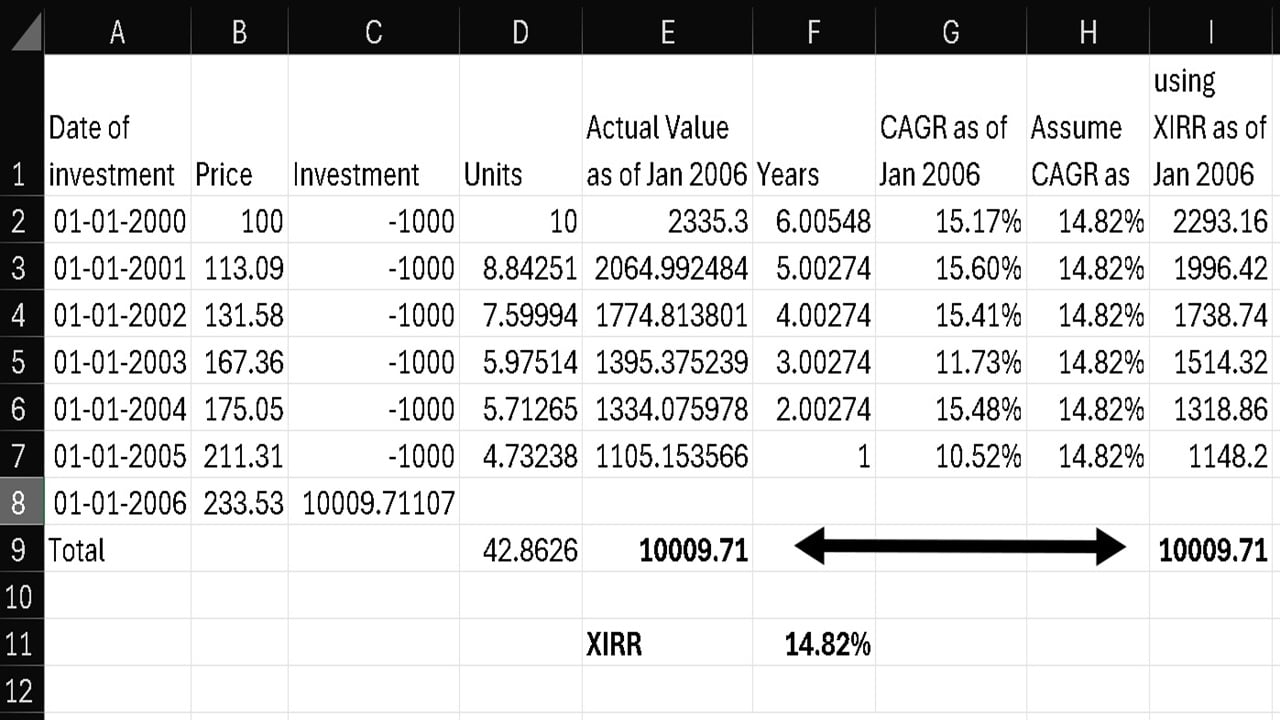You may have seen that mutual fund annualised returns are computed using a method known as XIRR (extended internal rate of return). We explain what this means using a simple example.
When you make a single investment (lump sum for want of a better word) in a mutual fund or stock, the return (after a minimum period of one year) is calculated using the standard compounding formula.
This is also known as the CAGR (compounded annual growth rate). This is simply the basic compounding formula: Value = Investment x (1+return)^years. Here ^ refers to “to the power of” like 2^2 = 2*2 = 4.
When you make multiple investments in a mutual fund (or any capital market-linked instrument), you use the XIRR as an equivalent of the CAGR. Both are measures of the annualised return.
Consider the following table. Investments of Rs 1000 are made on January 1, 2000, 2001, 2002, 2003, 2004, and 2005. A negative sign is necessary to use in the formula for the XIRR.
Join 32,000+ readers and get free money management solutions delivered to your inbox! Subscribe to get posts via email! (Link takes you to our email sign-up form)
🔥Want to create a complete financial plan? Learn goal-based investing? Exclusive access to our DIY tools? Increase your income with your skills? Use this link to enjoy massive discounts on our robo-advisory tool & courses! 🔥
| Date of investment | Amt |
| 01-01-2000 | -1000 |
| 01-01-2001 | -1000 |
| 01-01-2002 | -1000 |
| 01-01-2003 | -1000 |
| 01-01-2004 | -1000 |
| 01-01-2005 | -1000 |
| 01-01-2006 | 10009.71 |
As of 1st January 2006, these investments have a value of Rs. 10009.71.
The XIRR is computed on a spreadsheet using the function =XIRR(Value column, Date column), and for this example, it is 14.82%. This is a pretty vague result. Let us find out how this number comes about.
The investment of Rs. 1000 on 1st January 2000 has a value of Rs. 2335.3 on 1st January 2006. Similarly, we have.
| Date of investment | Value as of Jan 2006 |
| 01-01-2000 | 2335.30 |
| 01-01-2001 | 2064.99 |
| 01-01-2002 | 1774.81 |
| 01-01-2003 | 1395.38 |
| 01-01-2004 | 1334.08 |
| 01-01-2005 | 1105.15 |
| 01-01-2006 | |
| Sum | 10009.71 |
We can compute the CAGR of the investment made on 1st January 2000 as on 1st January 2006 using the standard compounding formula.
return = (Value/investment)^(1/years)
This return is 15.17%. Similarly, we have.
| Date of investment | CAGR as on 1st Jan 2006 |
| 01-01-2000 | 15.17% |
| 01-01-2001 | 15.60% |
| 01-01-2002 | 15.41% |
| 01-01-2003 | 11.73% |
| 01-01-2004 | 15.48% |
| 01-01-2005 | 10.52% |
The XIRR is not the average of these CAGR numbers! Then what is it?
To understand the XIRR, we consider the value of Rs. 1000 invested on 1st January 2000 as of 1st January 2006, assuming a return of 14.82% (the XIRR for our example).
The answer is (using the standard compounding formula again ) Rs. 2293.16 (this is different from the actual value of Rs 2335.30). If we repeat this exercise for the other investments, we have the following table.
| Date of investment | Value as of Jan 2006 if return was equal to XIRR of 14.82% | Actual Value as of Jan 2006 |
| 01-01-2000 | 2293.16 | 2335.30 |
| 01-01-2001 | 1996.42 | 2064.99 |
| 01-01-2002 | 1738.74 | 1774.81 |
| 01-01-2003 | 1514.32 | 1395.38 |
| 01-01-2004 | 1318.86 | 1334.08 |
| 01-01-2005 | 1148.20 | 1105.15 |
| Sum | 10009.71 | 10009.71 |
Although the individual “imaginary” present values differ from the actual present values, their sum remains the same! This gives you an idea of what the XIRR is.
The XIRR is that annualised compounding rate which, when applied to each investment, results in the correct total value on the date the return is computed.
This is summarised in the figure below.

The XIRR can then be computed by setting all individual CAGRs to be the same and by adjusting this value until the sum of the present value matches the actual present value. This can be accomplished by a function known as Goal Seek in Excel. Of course, the standard XIRR function is the easiest to use, but for understanding, the Goal Seek function can be used once. The above processes are explained in this video.
Internally, the XIRR or the Goal Seek Function is an implementation of the Newton-Raphson method (some of you may remember this from school).
In summary, the XIRR is the rate of return that each investment is assumed to grow to arrive at the observed total value on the date of computation. It is not an average CAGR!

Use our Robo-advisory Tool to create a complete financial plan! ⇐More than 3,000 investors and advisors use this! Use the discount code: robo25 for a 20% discount. Plan your retirement (early, normal, before, and after), as well as non-recurring financial goals (such as child education) and recurring financial goals (like holidays and appliance purchases). The tool would help anyone aged 18 to 80 plan for their retirement, as well as six other non-recurring financial goals and four recurring financial goals, with a detailed cash flow summary.
🔥You can also avail massive discounts on our courses and the freefincal investor circle! 🔥& join our community of 8000+ users!
Track your mutual funds and stock investments with this Google Sheet!
We also publish monthly equity mutual funds, debt and hybrid mutual funds, index funds, and ETF screeners, as well as momentum and low-volatility stock screeners.
You can follow our articles on Google News

We have over 1,000 videos on YouTube!

Join our WhatsApp Channel



- Do you have a comment about the above article? Reach out to us on Twitter: @freefincal or @pattufreefincal
- Have a question? Subscribe to our newsletter using the form below.
- Hit 'reply' to any email from us! We do not offer personalised investment advice. We can write a detailed article without mentioning your name if you have a generic question.
Join 32,000+ readers and get free money management solutions delivered to your inbox! Subscribe to get posts via email! (Link takes you to our email sign-up form)
About The Author
 Dr M. Pattabiraman (PhD) is the founder, managing editor and primary author of freefincal. He is an associate professor at the Indian Institute of Technology, Madras. He has over 13 years of experience publishing news analysis, research and financial product development. Connect with him via Twitter(X), LinkedIn, or YouTube. Pattabiraman has co-authored three print books: (1) You can be rich too with goal-based investing (CNBC TV18) for DIY investors. (2) Gamechanger for young earners. (3) Chinchu Gets a Superpower! for kids. He has also written seven other free e-books on various money management topics. He is a patron and co-founder of “Fee-only India,” an organisation promoting unbiased, commission-free, AUM-independent investment advice.
Dr M. Pattabiraman (PhD) is the founder, managing editor and primary author of freefincal. He is an associate professor at the Indian Institute of Technology, Madras. He has over 13 years of experience publishing news analysis, research and financial product development. Connect with him via Twitter(X), LinkedIn, or YouTube. Pattabiraman has co-authored three print books: (1) You can be rich too with goal-based investing (CNBC TV18) for DIY investors. (2) Gamechanger for young earners. (3) Chinchu Gets a Superpower! for kids. He has also written seven other free e-books on various money management topics. He is a patron and co-founder of “Fee-only India,” an organisation promoting unbiased, commission-free, AUM-independent investment advice.Our flagship course! Learn to manage your portfolio like a pro to achieve your goals regardless of market conditions! ⇐ More than 3,500 investors and advisors are part of our exclusive community! Get clarity on how to plan for your goals and achieve the necessary corpus no matter the market condition!! Watch the first lecture for free! One-time payment! No recurring fees! Life-long access to videos! Reduce fear, uncertainty and doubt while investing! Learn how to plan for your goals before and after retirement with confidence.
Increase your income by getting people to pay for your skills! ⇐ More than 800 salaried employees, entrepreneurs and financial advisors are part of our exclusive community! Learn how to get people to pay for your skills! Whether you are a professional or small business owner seeking more clients through online visibility, or a salaried individual looking for a side income or passive income, we will show you how to achieve this by showcasing your skills and building a community that trusts and pays you. (watch 1st lecture for free). One-time payment! No recurring fees! Life-long access to videos!
Our book for kids: “Chinchu Gets a Superpower!” is now available!


Must-read book even for adults! This is something that every parent should teach their kids right from their young age. The importance of money management and decision making based on their wants and needs. Very nicely written in simple terms. - Arun.Buy the book: Chinchu gets a superpower for your child!
How to profit from content writing: Our new ebook is for those interested in getting a side income via content writing. It is available at a 50% discount for Rs. 500 only!
Do you want to check if the market is overvalued or undervalued? Use our market valuation tool (it will work with any index!), or get the Tactical Buy/Sell timing tool!
We publish monthly mutual fund screeners and momentum, low-volatility stock screeners.
About freefincal & its content policy. Freefincal is a News Media organisation dedicated to providing original analysis, reports, reviews and insights on mutual funds, stocks, investing, retirement and personal finance developments. We do so without conflict of interest and bias. Follow us on Google News. Freefincal serves more than three million readers a year (5 million page views) with articles based only on factual information and detailed analysis by its authors. All statements made will be verified with credible and knowledgeable sources before publication. Freefincal does not publish paid articles, promotions, PR, satire or opinions without data. All opinions will be inferences backed by verifiable, reproducible evidence/data. Contact Information: To get in touch, please use our contact form. (Sponsored posts or paid collaborations will not be entertained.)
Connect with us on social media
- Twitter @freefincal
- Subscribe to our YouTube Videos
- Posts feed via Feedburner.
Our publications
You Can Be Rich Too with Goal-Based Investing
 Published by CNBC TV18, this book is designed to help you ask the right questions and find the correct answers. Additionally, it comes with nine online calculators, allowing you to create custom solutions tailored to your lifestyle. Get it now.
Published by CNBC TV18, this book is designed to help you ask the right questions and find the correct answers. Additionally, it comes with nine online calculators, allowing you to create custom solutions tailored to your lifestyle. Get it now.Gamechanger: Forget Startups, Join Corporate & Still Live the Rich Life You Want
 This book is designed for young earners to get their basics right from the start! It will also help you travel to exotic places at a low cost! Get it or gift it to a young earner.
This book is designed for young earners to get their basics right from the start! It will also help you travel to exotic places at a low cost! Get it or gift it to a young earner.Your Ultimate Guide to Travel
 This is an in-depth exploration of vacation planning, including finding affordable flights, budget accommodations, and practical travel tips. It also examines the benefits of travelling slowly, both financially and psychologically, with links to relevant web pages and guidance at every step. Get the PDF for Rs 300 (instant download)
This is an in-depth exploration of vacation planning, including finding affordable flights, budget accommodations, and practical travel tips. It also examines the benefits of travelling slowly, both financially and psychologically, with links to relevant web pages and guidance at every step. Get the PDF for Rs 300 (instant download)